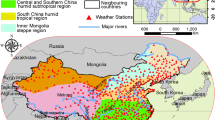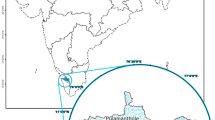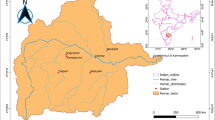Abstract
In drought analysis, many types of research have applied bivariate analysis. However, a more effective appraisal is achievable by employing three mutually correlated drought variables (i.e., duration, severity, peak) concurrently. This study adopted trivariate copulas for multivariate drought frequency estimation in seven climatic sub-regions and mainland China between 1961 and 2013. The joint distribution is modeled using nine trivariate copula functions, namely Clayton, Ali–Mikhail–Haq (AMH), Gumbel–Hougaard, Frank, M3, M4, M5, M6, and M12. The performance of the different copulas was evaluated using the root mean square error (RMSE), Akaike information criterion (AIC), bias, and graphical test. The results showed that trivariate Clayton copula performed better in modeling joint dependence structure of drought variables in contrast to other class of copulas in sub-regions I–VII and mainland China. Therefore, the Clayton copula–based drought joint distributions were used for the multivariate drought frequency analysis, regarding probabilities and return periods. The joint probabilities in the “OR” cases were greater than that of the “AND” cases in all the seven sub-regions and mainland China. There is every possibility that drought event occurrence will be given for “OR” cases. Accordingly, counter measures of drought hazards need to be set for proactive responses especially in sub-regions III, V, and VI. The trivariate return periods were compared with the univariate and bivariate return periods and discussed the need of multivariate drought frequency analysis. In conclusion, the Clayton trivariate copula is an excellent choice for efficient drought risk evaluation, and results are very handy in the design of water resource hydrologic systems under severe and extreme drought conditions.












Similar content being viewed by others
Abbreviations
- P, T, ET O :
-
Precipitation, temperature, potential evapotranspiration
- SPEI:
-
Standardized Precipitation Evapotranspiration Index
- Dd, Ds, Dp :
-
Drought duration, severity, and peak
- F(x):
-
Marginal distribution of drought variables
- CDF:
-
Cumulative distribution function
- FNA:
-
Fully nested Archimedean
- Γ(⋅), α, β, λ :
-
Gamma function, scale, shape, and location parameters
- n, x c(i), x 0(i):
-
Sample size, ith calculated value, ith observed value
- \( {P}_{DSP}^{\cap } \) :
-
Trivariate joint occurrence probability of Dd and Ds and Dp exceeding an actual value
- \( {P}_{DSP}^{\cup } \) :
-
Trivariate joint occurrence probability of Dd or Ds or Dp exceeding an actual value
- \( {T}_{DSP}^{\cap } \) :
-
Trivariate return period of Dd and Ds and Dp exceeding an actual value
- \( {T}_{DSP}^{\cup } \) :
-
Trivariate return period of Dd or Ds or Dp exceeding an actual value
- C DS (d, s):
-
Joint distribution of Dd and Ds
- C DP (d, p):
-
Joint distribution of Dd and Dp
- C SP (s, p):
-
Joint distribution of Ds and Dp
- C DSP (d,s,p):
-
Joint distribution of Dd, Ds, and Dp
References
Abramowitz M, Stegun IA (1965) Handbook of mathematical functions. Dover Publications, New York
AghaKouchak A, Bardossy A, Habib E (2010) Conditional simulation of remotely sensed rainfall fields using a non-Gaussian transformed copula. Adv Water Resour 33(6):624–634
Akaike H (1974) A new look at the statistical model identification. IEEE Trans Autom Control AC 19(6):716–723
Ayantobo OO, Li Y, Song S, Javed T, Yao N (2018a) Probabilistic modelling of drought events in China via 2-dimensional joint copula. J Hydrol 559:373–391
Ayantobo OO, Li Y, Song S (2018b) Multivariate drought frequency analysis using four-variate symmetric and asymmetric Archimedean copula functions. Water Resour Manag doi:https://doi.org/10.1007/s11269-018-2090-6
Bardossy A (2006) Copula-based geostatistical models for groundwater quality parameters. Water Resour Res 42:W11416
Bryant E (2004) Natural hazards. Cambridge University Press
Chebana F, Ouarada T (2011) Multivariate quantiles in hydrological frequency analysis. Environmetrics 22(1):63–78
Chen L, Singh VP, Gao S (2011) Drought analysis based on copulas. 2011 Symposium on data-driven approaches to droughts
Cunnane C (1978) Unbiased plotting positions—a review. J Hydrol 37(3–4):205–222
De Michele C, Salvadori G, Canossi M, Petaccia A, Rosso R (2005) Bivariate statistical approach to check adequacy of dam spillway. J Hydrol Eng 10(1):50–57
Embrechts P, Lindskog F, McNeil A (2003) Modeling dependence with copulas and applications to risk management. In: Handbook of heavy tailed distributions in finance. Elsevier Sci, New York, pp 329–384
Fleig AK, Tallaksen LM, Hisdal H, Demuth S (2006) A global evaluation of streamflow drought characteristics. Hydrol Earth Syst Sci 10:535–552
Ganguli P, Reddy MJ (2014) Evaluation of trends and multivariate frequency analysis of droughts in three meteorological subdivisions of western India. Int J Climatol 34(3):911–928
Genest C, Favre AC (2007) Everything you always wanted to know about copula modeling but were afraid to ask. J Hydrol Eng 12(4):347–368
Gocic M, Trajkovic S (2014) Spatiotemporal characteristics of drought in Serbia. J Hydrol 510:110–123
Grimaldi S, Serinaldi F (2006) Asymmetric copula in multivariate flood frequency analysis. Adv Water Resour 29(8):1115–1167
Gringorten II (1963) A plotting rule for extreme probability paper. J Geophys Res 68(3):813–814
Hargreaves GH, Samani ZA (1985) Reference crop evapotranspiration from temperature. Appl Eng Agric 1(2):96–99
Helsel DR, Hirsch RM (1992) Statistical methods in water resources. Elsevier, Amsterdam
Joe H (1997) Multivariate models and dependence concepts. Chapman and Hall, New York
Kao SC, Govindaraju RS (2007) Probabilistic structure of storm surface runoff considering the dependence between average intensity and storm duration of rainfall events. Water Resour Res 43:W06410
Kuhn G, Khan S, Ganguly AR, Branstetter ML (2007) Geospatial-temporal dependence among weekly precipitation extremes with applications to observations and climate model simulations in South America. Adv Water Resour Res 30:2401–2423
Lee T, Modarres R, Quarda TBMJ (2013) Data-based analysis of bivariate copula tail dependence for drought duration and severity. Hydrol Process 27(10):1454–1463
Liu X, Wang S, Zhou Y, Wang F, Yang G, Liu W (2015) Spatial analysis of meteorological drought return periods in China using copulas. Nat Hazards 80(1):367(22)
Ma M, Song S, Ren L, Jiang S, Song J (2013) Multivariate drought characteristics using trivariate Gaussian and Student t copulas. Hydrol Process 27(8):1175–1190
Madadgar S, Moradkhani H (2011) Assessment of climate change impacts on drought returns periods using copula. In: 2011 Symposium on Data-Driven Approaches to Droughts, paper 31.
McKee TB, Doesken NJ, Kleist J (1993) The relationship of drought frequency and duration to time scales. In: Proceedings of the 8th conference on applied climatology. American Meteorological Society, Anaheim, Calif
Mirabbasi R (2012) Bivariate drought frequency analysis using the copula method. Theor Appl Climatol 108(1–2):191–206
Mirakbari M, Ganji A, Fallah SR (2010) Regional bivariate frequency analysis of meteorological droughts. J Hydrol Eng 15(12):985–1000
Mishra AK, Singh VP (2010) A review of drought concepts. J Hydrol 391(1–2):202–216
Mishra AK, Desai VR (2005) Spatial and temporal drought analysis in the Kansabati river basin, India. Int J River Basin Manag 3(1):31–41
Montaseri M, Amirataee B (2017) Comprehensive stochastic assessment of meteorological drought indices. Int J Climatol 37:998–1013
Nelsen RB (1999) An introduction to copulas. Springer Verlag, New York, p 215
Nelsen RB (2006) An introduction to copulas. Springer, New York
Penman HL (1948) Natural evaporation from open water, bare soil, and grass. Proc R Soc Lond 193:120–146
Salvadori G, De Michele C (2004) Frequency analysis via copulas: theoretical aspects and applications to hydrological events. Water Resour Res 40:W12511
Salvadori G, De Michele C, Kottegoda NT, Rosso R (2007) Extremes in nature: an approach using copulas. Water Sci Technol library Ser, vol 56 Springer, New York
Salvadori G, De Michele C (2010) Multivariate multiparameter extreme value models and return periods: a copula approach. Water Resour Res 46:W10501
Savu C, Trede M (2004) Goodness-of-fit tests for parametric families of Archimedean copulas. University of Muenster, Discussion Paper, CAWM, p 6
Savu C, Trede M (2010) Hierarchies of Archimedean copulas. Quanti-tative Finance 10(3):295–304
Serinaldi F, Grimaldi S, (2007) Fully nested 3-copula: procedure and application on hydrological data. J Hydrol Eng 12(4):420–430
Serinaldi F, Bonaccorso B, Cancelliere A, Grimaldi S (2009) Probabilistic characterization of drought properties through copulas. Phys Chem Earth Parts A/B/C 34(10–12):596–605
Shiau JT (2006) Fitting drought duration and severity with two-dimensional copulas. Water Resour Manag 20:795–815
Shiau JT, Modarres R (2009) The copula-based drought severity-duration frequency analysis in Iran. J Appl Meteorol 16(4):481–489
Shiau JT, Wang HY, Chang TT (2006) Bivariate frequency analysis of floods using copulas. J Am Water Resour Assoc 42(6):1549–1564
Sklar A (1959) Fonctions de répartition à n dimensions et leurs marges. Publ Inst Statist Univ Paris 8:229–231
Song S, Singh VP (2010a) Frequency analysis of droughts using the Plackett copula and parameter estimation by genetic algorithm. Stoch Env Res Risk A 24:783–805
Song S, Singh VP (2010b) Meta-elliptical copulas for drought frequency analysis of periodic hydrologic data. Stoch Env Res Risk A 24:425–444
Vicente-Serrano SM, Begueria S, Lopez-Moreno JI (2010) A multiscalar drought index sensitive to global warming: the standardized precipitation evapotranspiration index. J Clim 23(7):1696–1718
Whelan N (2004) Sampling from Archimedean copulas. Quant Finance 4(3):339–352
Wong G, Lambert MF, Leonard M, Metcalfe AV (2010) Drought analysis using trivariate copulas conditional on climatic states. J Hydrol Eng 15(2):129–141
Wu ZY, Lu GH, Wen L, Lin CA (2011) Reconstructing and analyzing China’s fifty-nine year (1951–2009) drought history using hydrological model simulation. Hydrol Earth Syst Sci Discuss 8(1):1861–1893
Xu K, Yang D, Xu X, Lei H (2015) Spatio-temporal variation of drought in China during 1961-2012: a climatic perspective. J Hydrol 526:253–264
Zhai J, Su B, Gao C, Jiang T (2010) Spatial variation and trends in PDSI and SPI indices and their relation to streamflow in 10 large regions of China. J Clim 23:649–663
Zhang L, Singh VP (2006) Bivariate flood frequency analysis using the copula method. J Hydrol Eng 11(2):150–164
Zhang L, Singh VP (2007) Gumbel-Hougaard copula for trivariate rainfall frequency analysis. J Hydrol Eng 12(4):409–419
Zhao S (1983) A new scheme for comprehensive physical regionalization in China. Acta Geograph Sin:1–10 (In Chinese with English Abstract)
Acknowledgements
We thank the National Meteorological Information Center of China Meteorological Administration (CMA) for sharing the climatic data used in this study. Finally, the authors would like to thank all the anonymous reviewers for their valuable comments and suggestions towards improving the quality of this paper.
Funding
This work was supported by the National Key Research and Development Program of China (grant no. 2017YFC0403303), China Natural Science Foundation (no. U1203182), and the China 111 project (B12007).
Author information
Authors and Affiliations
Corresponding author
Additional information
Publisher’s note
Springer Nature remains neutral with regard to jurisdictional claims in published maps and institutional affiliations.
Rights and permissions
About this article
Cite this article
Ayantobo, O.O., Li, Y. & Song, S. Copula-based trivariate drought frequency analysis approach in seven climatic sub-regions of mainland China over 1961–2013. Theor Appl Climatol 137, 2217–2237 (2019). https://doi.org/10.1007/s00704-018-2724-x
Received:
Accepted:
Published:
Issue Date:
DOI: https://doi.org/10.1007/s00704-018-2724-x




